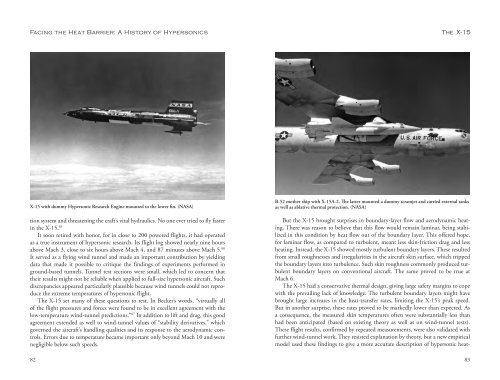Facing the Heat Barrier - NASA's History Office
Facing the Heat Barrier - NASA's History Office
Facing the Heat Barrier - NASA's History Office
Create successful ePaper yourself
Turn your PDF publications into a flip-book with our unique Google optimized e-Paper software.
<strong>Facing</strong> <strong>the</strong> <strong>Heat</strong> <strong>Barrier</strong>: A <strong>History</strong> of Hypersonics<br />
X-15 with dummy Hypersonic Research Engine mounted to <strong>the</strong> lower fin. (NASA)<br />
tion system and threatening <strong>the</strong> craft’s vital hydraulics. No one ever tried to fly faster<br />
in <strong>the</strong> X-15. 85<br />
It soon retired with honor, for in close to 200 powered flights, it had operated<br />
as a true instrument of hypersonic research. Its flight log showed nearly nine hours<br />
above Mach 3, close to six hours above Mach 4, and 87 minutes above Mach 5. 86<br />
It served as a flying wind tunnel and made an important contribution by yielding<br />
data that made it possible to critique <strong>the</strong> findings of experiments performed in<br />
ground-based tunnels. Tunnel test sections were small, which led to concern that<br />
<strong>the</strong>ir results might not be reliable when applied to full-size hypersonic aircraft. Such<br />
discrepancies appeared particularly plausible because wind tunnels could not reproduce<br />
<strong>the</strong> extreme temperatures of hypersonic flight.<br />
The X-15 set many of <strong>the</strong>se questions to rest. In Becker’s words, “virtually all<br />
of <strong>the</strong> flight pressures and forces were found to be in excellent agreement with <strong>the</strong><br />
low-temperature wind-tunnel predictions.” 87 In addition to lift and drag, this good<br />
agreement extended as well to wind-tunnel values of “stability derivatives,” which<br />
governed <strong>the</strong> aircraft’s handling qualities and its response to <strong>the</strong> aerodynamic controls.<br />
Errors due to temperature became important only beyond Mach 10 and were<br />
negligible below such speeds.<br />
82<br />
The X-15<br />
B-52 mo<strong>the</strong>r ship with X-15A-2. The latter mounted a dummy scramjet and carried external tanks<br />
as well as ablative <strong>the</strong>rmal protection. (NASA)<br />
But <strong>the</strong> X-15 brought surprises in boundary-layer flow and aerodynamic heating.<br />
There was reason to believe that this flow would remain laminar, being stabilized<br />
in this condition by heat flow out of <strong>the</strong> boundary layer. This offered hope,<br />
for laminar flow, as compared to turbulent, meant less skin-friction drag and less<br />
heating. Instead, <strong>the</strong> X-15 showed mostly turbulent boundary layers. These resulted<br />
from small roughnesses and irregularities in <strong>the</strong> aircraft skin surface, which tripped<br />
<strong>the</strong> boundary layers into turbulence. Such skin roughness commonly produced turbulent<br />
boundary layers on conventional aircraft. The same proved to be true at<br />
Mach 6.<br />
The X-15 had a conservative <strong>the</strong>rmal design, giving large safety margins to cope<br />
with <strong>the</strong> prevailing lack of knowledge. The turbulent boundary layers might have<br />
brought large increases in <strong>the</strong> heat-transfer rates, limiting <strong>the</strong> X-15’s peak speed.<br />
But in ano<strong>the</strong>r surprise, <strong>the</strong>se rates proved to be markedly lower than expected. As<br />
a consequence, <strong>the</strong> measured skin temperatures often were substantially less than<br />
had been anticipated (based on existing <strong>the</strong>ory as well as on wind-tunnel tests).<br />
These flight results, confirmed by repeated measurements, were also validated with<br />
fur<strong>the</strong>r wind-tunnel work. They resisted explanation by <strong>the</strong>ory, but a new empirical<br />
model used <strong>the</strong>se findings to give a more accurate description of hypersonic heat-<br />
83
















